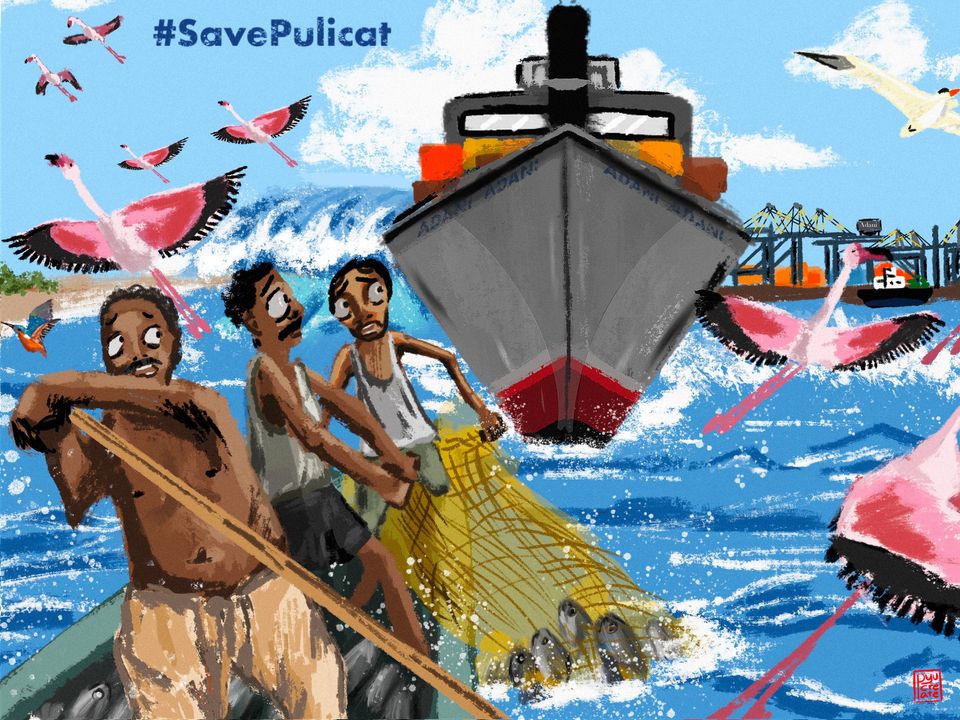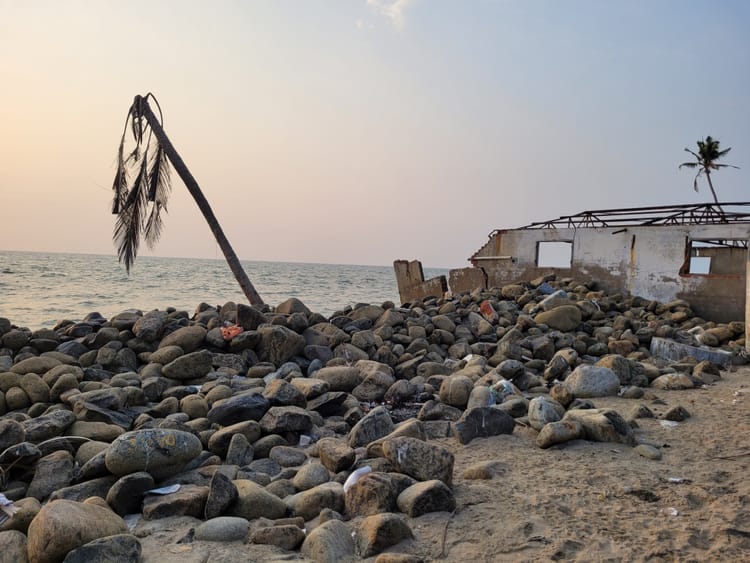#5 Are port-projects choking India's fishers?

On 18th August, from 6pm to 8pm, Twitter (X) was abuzz in India. A hashtag, #StopAdaniSaveChennai was doing the rounds. An upcoming port-expansion project in the northern outskirts of Chennai, Tamil Nadu in southern India is threatening to destroy a fragile ecosystem and livelihoods.
The Kattupalli port is classified as a minor port by Tamil Nadu Maritime Board. Located in Thiruvallur district, 30 km north of Chennai along the coastline, the port serves the ‘hinterland of North Tamil Nadu, Chennai Region, Bangalore region and South Andhra Pradesh' via sea transport. In June 2018, Adani Ports and SEZ Ltd (APSEZ) acquired a 97 percent stake in Marine Infrastructure Developer Pvt Ltd, the developer and operator of the Katupalli port from Larsen and Toubro, changing the name to Adani Katupalli Port Limited. Making an investment of Rs 53000 crore (approx 6 billion USD), Adani Ports wants to expand the capacity of the port from 25 to 320 million metric ton to handle more and diversified cargo of fertilisers, agricultural commodity, mines and minerals, steel and project cargo, break bulk, automobile, general cargo and liquid cargo. The port’s area is to expand from the current 330 acres to nearly 20 times its size — a whopping 6,111 acres. Out of this, about 2000 acres of land is being reclaimed from the sea.
Environmentalists, activists, fishers and farmers of the region are vociferously raising their voices against the port expansion. The port is set to come up on wetlands and ecologically fragile sand dunes on the Kattupalli Barrier island near the Pulicat Wildlife Sanctuary. The Pulicat lagoon is the second largest brackish water lagoon in the country. The lagoon encompasses the Pulicat Lake Bird Sanctuary. The island also serves as a natural barrier against cyclones and floods.
The extension of the port stands to erode the northern part of the coast at a rate of 16 metres per year. At present, the erosion rate is 8.6 m / year.
There are nearly 80 fishing community villages in and around the seashore. The port will impact the livelihood of nearly 50,000 fishers and fishing vendors. According to a 2021 essay by Nityanand Jayaraman:
"The marine area proposed to be reclaimed for creating 2,000 acres of port land will obliterate at least six named fishing grounds: Karungali seru (seru is tamil for ‘mud’), Alamaram seru, Kalanji seru, Lock seru, Kalanji Koda seru and Koda seru. The locals refer to the muddy-bottomed prawn and crab habitats dotting the nearshore areas as the “reserve bank” because of the perennial availability of cash-fish."
In December 2022, The Hindu reported the presence of an invasive specie of mussel in Ennore and Pulicat, that prevents prawns from grazing by spreading over the riverbed like a carpet. Fishers have said that it is wiping out the locally prevalent yellow clams and green mussels. The specie is known as Mytella strigata or Charru mussels. Native to South America, these mussels have invaded tidal wetlands in several parts of the world by travelling across continents in the ballast waters of ships.
A public hearing for the port has been scheduled for September 5.
"India’s long coastline awaits you. Let Indian ports be your port of call for trade and commerce."
These were the words uttered by the Indian prime minister at an event in March 2021. He also said that India has plans to invest US$ 82 billion in port projects by 2035.
India has twelve major ports and about 200 minor ports dotting its 7500km long coastline. While a major port comes under the aegis of the central government, the minor ports are controlled by state governments. A major port has deeper drafts allowing large, capesize vessels, higher investments and higher tariffs. A minor port, in comparison, has lower tariffs.
There is a keen interest in the port-led development model in India, which is being driven by a high projected growth in external trade. Waterways are one of the cheapest modes of freight transport. At the moment, about 87 percent of Indian freight either uses rail or road for transportation of cargo, and waterborne transport accounts for less than six percent. Industry insiders say that better connectivity between ports through inland and coastal waterways is economically efficient. They also say that port development would connect the hinterland industries with the ports via a better road and railway network, leading to the idea of a projected growth; infrastructure creating its own demand.
In the Union Budget 2023-24, the total budget allocation for the Ministry of Ports, Shipping and Waterways was Rs 2218 crore (USD 1,813.16 million )
The Indian Government plays an important role in supporting the ports sector. It has allowed Foreign Direct Investment (FDI) of up to 100 percent for port and harbour construction and maintenance projects. It has also facilitated a 10-year tax holiday to enterprises that develop, maintain, and operate ports, inland waterways and inland ports. The government also allows up to 50 percent financial aid – subject to a maximum of Rs 25 crore (USD 3.88 million) – for investing companies.
In addition, the government has also proposed 14 coastal economic zones (CEZs), which will link coastal districts to ports. Such CEZs are envisioned to be much bigger than India’s Special Economic Zones (SEZs), extending 500 kms along the coastline and 300 km inland. They will have coastal economic units for manufacturing facilities. The CEZs are also expected to aid the planned industrial corridors, such as the Visakhapatnam-Chennai Industrial Corridor as well as the Delhi-Mumbai Industrial Corridor.
In a statement recently, the union minister of shipping, ports and waterways declared that "The total country’s Port capacity will increase from existing around 2,600 MTPA to more than 10,000 MTPA in 2047."
In line with this vision, the role of private players is becoming increasingly important. Public-Private Partnership (PPP) terminals currently handle about 50% of the cargo at major ports and efforts are underway to raise their share to approximately 85% in the coming decades. This move towards privatisation is expected to enhance efficiency and facilitate the scaling up of operations.
Under this increasing spate of privatization, the lion's share seems to be going to Adani Ports and SEZ Ltd (APSEZ). They call themselves India’s largest private port operator and an end-to-end logistics provider, and aspire to become the world's largest private port company and India's largest integrated transport utility by 2030. Currently, they have 13 ports and terminals that represent 24% of the country’s port capacity.
If India truly believes that ports bring about economic prosperity and development, then why are traditional fishers often the first casualties?
We have seen this tragedy play out in a number of locations. In November 2022, Vizhinjam, a coastal region in the southern district of Kerala, erupted in protests for the umpteenth time. The clash was between the fishing community and the state over an upcoming port project led by APSEZ.
The fishing community of Vizhinjam took the state and the port to court, on grounds that the port is costing them their livelihoods, the erasure of their homes, and the erosion of their coastline. The court ordered the port to resume construction, and the state labelled the protests “anti-people” and “anti-development.”
In January last year, protests erupted in Honnavar, a small, unassuming coastal region in the Uttara Kannada district of Karnataka, known for having a locally thriving dried fish economy. Three port projects are projected to come up on the constantly shifting coastal sand spit, all commercial, all public-private partnerships. Fishers and researchers are convinced they stand to destroy the
rich fish breeding grounds, and ultimately, their lives.
Communities living by the coast are displaced, because where else will the land for construction come from. Jobs are a myth. And the continuous dredging activity destroys the biodiversity irreversibly. As a marine biologist told me once, “Dredging turns a seabed into a cemetary. How and why will the fish be here?”
Recommended readings:
A comprehensive 2021 essay by Nityanand Jayaraman about the Kattupalli port expansion project: https://science.thewire.in/politics/rights/illegal-and-unnecessary-but-adani-port-proposal-makes-it-to-public-hearing-stage/
A lyrical essay by Yuvan Aves on the beauty of Pulicat lagoon and all that stands to get destroyed if the port project comes through: https://sanctuarynaturefoundation.org/article/a-pulicat-story%3A-the-lagoon-that-protects-a-city
A detailed on-ground reportage by Geetha Srimathi on the brewing resistance against the port project: https://www.thehindu.com/news/cities/chennai/fresh-resistance-to-kattupalli-port-expansion-spotlights-broken-promises/article67215643.ece
A quick glance at the conflict on the Environment Justice Atlas website: https://ejatlas.org/conflict/kattupalli-port-expansion-conflict
In Other News:
Japan has started releasing treated nuclear water from its Fukushima plant into the Pacific Ocean. According to Bloomberg, approximately 1.3 million metric tons of wastewater — enough to fill about 500 Olympic-size swimming pools — will be discharged slowly over about the next 30 years. https://twitter.com/business/status/1694577699241812294
Fishing groups in Fukushima have opposed this plan, fearing it would taint the reputation of their catch and affect their livelihood: https://www.bloomberg.com/news/articles/2023-07-04/is-it-safe-japan-set-to-release-treated-fukushima-nuclear-water-into-ocean
China intends to ban Japanese seafood after nuclear wastewater is released. https://www.theguardian.com/environment/2023/aug/24/japan-begins-releasing-fukushima-wastewater-into-pacific-ocean


